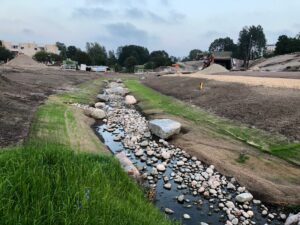Social-Ecological-Technological Framework for Studying Urban Aquatic Nature-Based Solutions in Cities
By Kati Vierikko and Pedro Pinho
BiNatUr team published a book chapter in 2023 focusing on the use of a holistic framework to encompass the functioning of aquatic nature-based solutions (aquaNbS). The framework is based on the social, technologic, and social dimensions, and propose that there is a need to characterize the interactions of these dimensions to have a comprehensive analysis and understanding of urban aquaNbS and to support their successful implementation and management.
Aquatic nature-based solutions, or ‘aquaNbS’, in urban environment include a diverse range of natural, restored, or completely human-made ponds, streams, and wetlands. These ecosystems can support biodiversity and provide crucial regulating ecosystem services, such as flood control, regulation of water quality, but also many cultural ecosystem services (e.g., wellbeing, recreation). Currently, aquaNbS are often perceived as mere plug-in remedies tailored for particular problems. Rather than standalone solutions, aquaNbS should be recognised as solutions framed and facilitated by societal needs, goals, and plans. They possess ecological benefits by supporting habitat functions and species diversity, consequently enhancing ecosystem services. Technological innovations further underpin and augment the effectiveness of aquaNbS. Assigning too much weight to a single function can lead to ineffective management and maintenance of aquaNbS. Therefore, they should be recognized as complex systems influenced by various social, ecological, and technological factors.


Figure 1. Examples of different aquatic nature-based solutions. Left-hand side: constructed, completely human-made urban stream in Helsinki, Finland. Right-hand side: modified urban stream in Berlin, Germany. Photos by Kati Vierikko.
The Social-Ecological-Technological Framework
Cities are often regarded as a complex social-ecological-technical system (SETS), and research on SETS is usually applied to broader areas or the entire city level. We propose that aquaNbS can also be viewed as a complex SETS. Specifically, we argue that social, ecological, and technological components interact with each other through the provision of services or disservices—whether ecological or technological—and through governance and values. In brief, social interactions refer to governance and values, while ecological and technological interactions pertain to different ecosystem (dis)services. Each dimension of the SETS that constitutes an aquaNbS operates at multiple spatial scales—ecological (habitat, ecosystem, catchment), social (place, block, neighbourhood, city), and technological (local swales and pipes, surrounding buildings, water sewage system).

Figure 2. The SETS framework in the context of aquatic nature-based solutions.
Essential variables for monitoring aquatic nature-based solutions within the SETS framework
To fully unleash the potential of aquaNbS, we propose potential indicators to quantitatively and qualitatively measure different components of SETS. These indicators share the common ability to take into account interactions between the three SETS dimensions. Within the social dimension, the governance of aquaNBS can be examined through publicly accessible documents such as land use planning strategies, city master plans, zoning documents, climate adaptation strategies, as well as green infrastructure and biodiversity strategies. These documents outline current policy objectives and provide context for NbS. Values can be defined, understood, or analysed from various angles and disciplines. We interpret values as information sources, although other types of values are crucial, especially in place-based transdisciplinary research and in adopting collaborative governance in planning, designing, and implementing NbS. Value indicators can be used to describe population demographics (sensitive and minority groups), health aspects or environmental equity (e.g., participation and accessibility).
For ecological dimensions, monitoring biodiversity within a specific area, such as the catchment or stream where an aquatic nature-based solution has been implemented, is quantified by species count. In addition to assessing species richness and evenness, biodiversity can be evaluated using metrics like the Simpson Index or the Shannon-Wiener Diversity Index. Similarly, land use or landscape diversity can be assessed by examining individual land use classes or the entire landscape, incorporating various land use classes or habitats, respectively, in a similar manner. The origin of water in aquaNbS and the regulation capacity of water can be detected by conducting isotope analyses on sites, as well as reference samples from rain, tap, and groundwater.
The technological dimension encompasses various aspects, including buildings with diverse heights, shapes, and surface characteristics. Additionally, it involves grey infrastructures such as sealed streets, squares, and paved front and backyards. These soil sealing attributes can be assessed using earth observation / remote sensing data, utilising techniques such as spectral unmixing technologies. Technological indicators are designed to measure the engineered or constructed features of aquaNbS and their surroundings that impact their functionality. This encompasses factors like the extent of canalisation (to determine water flow velocity), the amount of concrete or other construction materials in the NbS, and the level of in-situ seepage capacity around buildings.
References
Pinho, P., Haase, D., Gebler, D., Staes, J., Martelo, J., Schoelynck, J., Szoszkiewicz, K., Monaghan, M. T. & Vierikko, K. (2023). Urban Aquatic Nature-Based Solutions in the Context of Global Change: Uncovering the Social-ecological-technological Framework. In: Hensel MU, Hensel S, Binder D, Ludwig CR (eds) Introduction to Designing Environments. Designing Environments. Springer. https://doi.org/10.1007/978-3-031-34378-0_8

Project funders:
This research was funded through the 2020-2021 Biodiversa and Water JPI joint call for research projects, under the BiodivRestore ERA-NET Cofund (GA N°101003777), with the EU and the funding organisations The Research Foundation - Flanders (FWO), Belgium; Academy of Finland (AKA), VDI/VDE-IT, Germany; National Science Center (NCN), Poland and Fundação para a Ciência e Tecnologia (FCT), Portugal

